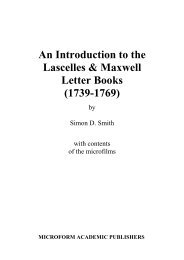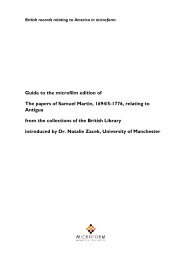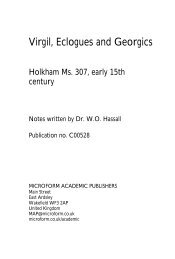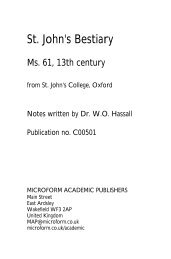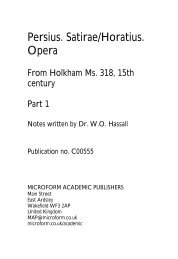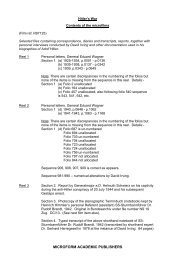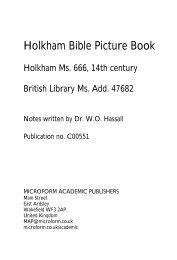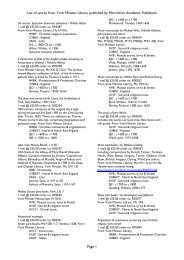An introduction to the plantation journals of the Prospect ... - Microform
An introduction to the plantation journals of the Prospect ... - Microform
An introduction to the plantation journals of the Prospect ... - Microform
You also want an ePaper? Increase the reach of your titles
YUMPU automatically turns print PDFs into web optimized ePapers that Google loves.
may be deficient, however, <strong>the</strong> overall conclusion <strong>of</strong> Table 3 that <strong>Prospect</strong> was not<br />
able <strong>to</strong> maintain itself by natural increase is sound. 46<br />
<strong>Prospect</strong>’s <strong>journals</strong> state <strong>the</strong> causes <strong>of</strong> death in <strong>the</strong> case <strong>of</strong> sixty-seven<br />
individuals dying between 1784 and 1792 (Table 6) This information provides an<br />
additional perspective on survival, though it suffers from serious limitations. The data<br />
excludes <strong>the</strong> very young, whilst forensic examinations and pathology were imprecise<br />
sciences during <strong>the</strong> later eighteenth century. It must also be borne in mind that <strong>the</strong><br />
reports were compiled for an absentee owner anxious <strong>to</strong> understand how his<br />
valuable capital (for this is how <strong>the</strong> enslaved were viewed) had been lost. The<br />
<strong>Prospect</strong> entries, however, do not exhibit <strong>the</strong> signs <strong>of</strong> overt prejudice apparent on<br />
o<strong>the</strong>r Jamaican properties. There are no instances, for example, <strong>of</strong> a slave dying<br />
through ‘self-neglect’.<br />
Diagnosis <strong>of</strong> mortality on <strong>Prospect</strong> can be compared with Worthy Park: a<br />
larger and longer-established, inland sugar estate located in Lluidas Vale in <strong>the</strong><br />
central Jamaican parish <strong>of</strong> St. John. 47 The Worthy Park dataset is one <strong>of</strong> <strong>the</strong> largest<br />
that has been assembled; it contains 401 entries, spanning <strong>the</strong> years from 1783 until<br />
1838. Attributed causes <strong>of</strong> death on <strong>Prospect</strong> and Worthy Park share some<br />
similarities. On both properties, ‘old age’ accounted for a large share <strong>of</strong> mortality:<br />
22.2 percent on Worthy Park and 17.9 percent on <strong>Prospect</strong>. Yaws and ulcers (9.5<br />
percent at Worthy Park and 11.9 percent <strong>of</strong> deaths on <strong>Prospect</strong>) were also major<br />
killers; <strong>the</strong> acute sores and skin inflammations associated with this disease afflicted<br />
many <strong>of</strong> <strong>the</strong> enslaved throughout <strong>the</strong>ir lives. A fur<strong>the</strong>r similarity is <strong>the</strong> failure <strong>of</strong> each<br />
data source <strong>to</strong> record female deaths during childbirth (perhaps <strong>the</strong> most notable<br />
single omission). One striking difference is that Worthy Park’s deaths include<br />
proportionately more cases <strong>of</strong> dysentery, fevers (including measles), gastro-intestinal<br />
problems, influenza, and pneumonia. The likely reason for <strong>the</strong> disparity is that <strong>the</strong>se<br />
diseases accounted for a large number <strong>of</strong> infant deaths which are not as consistently<br />
specified in <strong>Prospect</strong>’s accounts. 48<br />
Sugar cultivation and rum production was carried out at <strong>Prospect</strong> using <strong>the</strong><br />
gang system: a method <strong>of</strong> allocating tasks used extensively on sugar estates in<br />
Jamaica. 49 A detailed contemporary description <strong>of</strong> <strong>the</strong> tripartite gang system in use<br />
on <strong>the</strong> island was published by Bryan Edwards in 1793. Edwards describes how <strong>the</strong><br />
first gang, consisting <strong>of</strong> women and men in relatively good physical condition, was<br />
employed in clearing land, ‘holing’ <strong>the</strong> ground in preparation for sugar, and planting<br />
<strong>the</strong> cane. During crop-time, workers from this group were also re-allocated <strong>to</strong> tend<br />
<strong>the</strong> crushing mill and boiling houses at <strong>the</strong> works. Edwards suggested that on most<br />
<strong>plantation</strong>s a third <strong>of</strong> <strong>the</strong> labour force belonged <strong>to</strong> this set. He went on <strong>to</strong> explain that<br />
<strong>the</strong> second gang was composed <strong>of</strong> children <strong>of</strong> both sexes, pregnant women, older<br />
members <strong>of</strong> <strong>the</strong> enslaved population, and individuals convalescing after illness. This<br />
group was employed in weeding cane fields and o<strong>the</strong>r ‘lighter’ work. The third gang<br />
usually consisted <strong>of</strong> younger children. Edwards indicated that <strong>the</strong> children’s gang not<br />
only performed useful tasks (such as weeding provision grounds and ga<strong>the</strong>ring<br />
fodder <strong>to</strong> feed animals), but also that gang membership helped inculcate habits <strong>of</strong><br />
industry. 50 Each <strong>of</strong> <strong>the</strong> three groups was headed by a ‘driver’ and given a daily<br />
9



